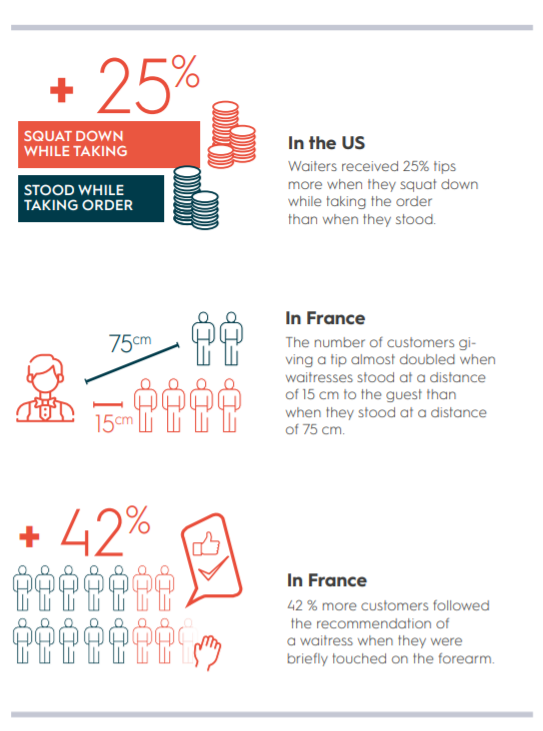 This article focuses on the power of touch in service encounters. It is a timely topic as physical distances in restaurants have never been so important. In many countries, restaurants are closed. In other countries, tables in restaurants are kept separate at a significant distance, and service providers and customers wear masks. Social distancing is nowadays required. Touch is no longer a sign of care and affection but may constitute a fatal weapon.
This article focuses on the power of touch in service encounters. It is a timely topic as physical distances in restaurants have never been so important. In many countries, restaurants are closed. In other countries, tables in restaurants are kept separate at a significant distance, and service providers and customers wear masks. Social distancing is nowadays required. Touch is no longer a sign of care and affection but may constitute a fatal weapon.
Even before the pandemic, many people unfavorably perceived touch, considering tactile contact among service providers and guests as inappropriate or even rude. When developing a customer experience strategy, how do we find a happy medium for this essential component of service culture in these Covid times?
Some robust findings on the positive effect of touch
Despite its negative appeal, many scientific studies have shown that individuals who touch others are more likely to be helped in return. For instance, when briefly touched on the arm or the shoulder, women are more likely to give their phone number to a man in a bar. Bystanders are more likely to fill in a questionnaire handed in by a research assistant, and customers are more likely to give a large tip. Other studies have shown that bystanders are more likely to give money or sign a petition when touched. Finally, customers are more likely to follow a waiter’s recommendations when touched. The precise psychological mechanisms that explain the effectiveness of touch are still debated, but there is no dispute on the beneficial effects of touch during social interactions. It seems that when one briefly touches another person, we make a better impression on them. Service providers might then appear more likeable and friendly by briefly touching their guests when interacting with them.
Some resistance against touch
If touch seems to bring so many benefits, why is it not used more often? There might be several explanations. First, there are substantial individual differences regarding the propensity to touch. Some individuals feel more naturally inclined to touch than others. Second, it might be perceived as an invasion of personal space in many cultures or social settings. This is particularly true in the hotel and restaurant industry, where employees are expected to act professionally and not disturb the guests.
When I tried to train service providers in the use of touch, I encountered a lot of resistance. This was partly due to the perceived ineffectiveness of this approach. I responded that it might be inappropriate to touch everyone but that, on average, customers would respond positively. It means that some customers might not be affected (neither positively nor negatively), that some of them could be affected negatively, but that the majority will be impacted positively.
When and how can we touch others?
It seems that touching others might have a more positive effect on younger customers than older ones. It also seems that touching a person of the opposite sex when this person is eating with their partner could have negative consequences. Touching will probably be better perceived in a casual-dining restaurant than in a fine-dining restaurant. Another aspect to keep in mind is that it should not be too prolonged. It should be very short, which means customers might even not realize they have been touched, but it would nevertheless influence their impression of the service provider. It might be appropriate to briefly touch the guest to gently interrupt a conversation, when asking certain questions (“How was your meal?”) or when providing indications (“Here is the menu”). I would also recommend to touch either the arm or the shoulder but no other part. Finally, I would suggest to touch only if the customer seems in a good mood.
Other behaviors that convey friendliness and likeability
We might wonder if we need to touch others to make a favorable impression? Of course, not. It is precisely for this reason that the power of touch is fascinating. On some occasions, just the simple act of touching a person will be sufficient to enhance perceived friendliness. But it shows how important it is to be friendly. It might be difficult for restaurant employees to create a warm atmosphere with guests during the service encounter. Restaurant employees have a variety of non-verbal behaviors at their disposal to convey immediacy and likeability, such as smiling, nodding, standing as close as possible to the guest, and looking at the guests. They can also introduce their name to the guest, offer additional (and unexpected) chocolates, or write a personal thank-you note on the bill, or draw if they feel they have the requisite skills. Finally, they may ask questions, “How are you today?”, “Is it the first time in our restaurant?”. Through simple questions, they can make customers open up and disclose information that might positively impact the waiters’ and waitress’ likeability.
Conveying friendliness in time of Covid
Given the current pandemic situation, it is highly inappropriate to touch customers. We don’t even know if it may ever be perceived positively again. As long as employees wear masks, it will be more challenging to build rapport with guests. As the service provider’s smile is now hidden behind a mask, hospitality employees have to find innovative ways to convey likeability. In addition to the techniques listed above, employees could occasionally come to the table to ask if customers are satisfied with the food and if they need anything else. When customers ask for bread or order a drink, employees can confirm they have understood by nodding their head or with a wink. They might also give back the change directly in the customer’s palm.
To conclude, the power of touch has been demonstrated in a variety of contexts. Patients, students, customers, or simply bystanders who are briefly touched are more likely to help than those who are not touched. When service providers touch customers, they signal sympathy and willingness to help. As long as social distancing is required, it will not be possible for service providers to demonstrate their friendliness through this medium. However, when we return to the ‘old normal’, service providers should not be refrained from briefly touching the guests because it seems to enhance customer evaluation of the staff and increase the magnitude of the tips offered to them.

































